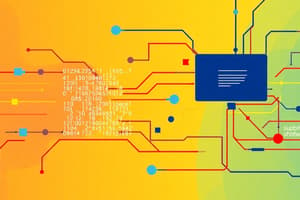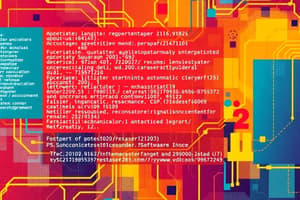Podcast
Questions and Answers
Tasks that are repetitive are good candidates for automation.
Tasks that are repetitive are good candidates for automation.
True (A)
Programming requires a complex understanding of human emotions and creativity.
Programming requires a complex understanding of human emotions and creativity.
False (B)
Portability refers to the capability of moving a solution from one type of computer to another.
Portability refers to the capability of moving a solution from one type of computer to another.
True (A)
Compilation is the process of converting code into natural language.
Compilation is the process of converting code into natural language.
The system development life cycle (SDLC) has five steps.
The system development life cycle (SDLC) has five steps.
An integrated development environment (IDE) is a tool that assists in writing and testing programs.
An integrated development environment (IDE) is a tool that assists in writing and testing programs.
Information systems can help in planning and decision making.
Information systems can help in planning and decision making.
A problem statement is crucial for understanding programming goals.
A problem statement is crucial for understanding programming goals.
Variables are used solely for output manipulation in a program.
Variables are used solely for output manipulation in a program.
A testing plan includes specific input numbers that users are expected to enter.
A testing plan includes specific input numbers that users are expected to enter.
Algorithms cannot be represented through flowcharts.
Algorithms cannot be represented through flowcharts.
Debugging involves running the program repeatedly to identify errors.
Debugging involves running the program repeatedly to identify errors.
Error handling refers to managing valid inputs.
Error handling refers to managing valid inputs.
An interpreter translates the entire source code at once before execution.
An interpreter translates the entire source code at once before execution.
Binary decisions are questions that can only be answered with true or false.
Binary decisions are questions that can only be answered with true or false.
Top-down design involves breaking a problem into low-level tasks.
Top-down design involves breaking a problem into low-level tasks.
Macros can execute a complicated sequence of steps with multiple commands.
Macros can execute a complicated sequence of steps with multiple commands.
Logical errors in a program are identified during execution.
Logical errors in a program are identified during execution.
A career in programming generally offers strong salaries.
A career in programming generally offers strong salaries.
External testing involves a group of developers using the program internally.
External testing involves a group of developers using the program internally.
Data is the end result needed at the conclusion of a process.
Data is the end result needed at the conclusion of a process.
Inheritance in object-oriented design allows a new class to inherit data and methods from an existing class.
Inheritance in object-oriented design allows a new class to inherit data and methods from an existing class.
Comments in programming help to explain code sections.
Comments in programming help to explain code sections.
Translating an algorithm into a programming language is called compiling.
Translating an algorithm into a programming language is called compiling.
Pseudocode is a text-based method for documenting algorithms.
Pseudocode is a text-based method for documenting algorithms.
Looping involves asking a question multiple times until a specific condition is met.
Looping involves asking a question multiple times until a specific condition is met.
Flashcards
Automation
Automation
Using computers to perform tasks, often replacing human input.
Information System
Information System
A system using data, people, procedures, hardware, and software to aid planning/decision making.
System Development Life Cycle (SDLC)
System Development Life Cycle (SDLC)
The process for creating and deploying a new computer system.
Programming
Programming
Signup and view all the flashcards
Problem Statement
Problem Statement
Signup and view all the flashcards
Data
Data
Signup and view all the flashcards
Information
Information
Signup and view all the flashcards
Method
Method
Signup and view all the flashcards
Error Handling
Error Handling
Signup and view all the flashcards
Program Development Life Cycle (PDLC)
Program Development Life Cycle (PDLC)
Signup and view all the flashcards
Testing Plan
Testing Plan
Signup and view all the flashcards
Algorithm
Algorithm
Signup and view all the flashcards
Flowchart
Flowchart
Signup and view all the flashcards
Pseudocode
Pseudocode
Signup and view all the flashcards
Decision Point
Decision Point
Signup and view all the flashcards
Binary Decision
Binary Decision
Signup and view all the flashcards
Loop
Loop
Signup and view all the flashcards
Top-Down Design
Top-Down Design
Signup and view all the flashcards
Class (Object-Oriented)
Class (Object-Oriented)
Signup and view all the flashcards
Inheritance (Object-Oriented)
Inheritance (Object-Oriented)
Signup and view all the flashcards
Programming Language
Programming Language
Signup and view all the flashcards
Compilation
Compilation
Signup and view all the flashcards
Interpreter
Interpreter
Signup and view all the flashcards
Variable
Variable
Signup and view all the flashcards
IDE
IDE
Signup and view all the flashcards
Debugging
Debugging
Signup and view all the flashcards
Testing
Testing
Signup and view all the flashcards
Software Release Stages
Software Release Stages
Signup and view all the flashcards
Portability
Portability
Signup and view all the flashcards
Study Notes
Technology in Action - Chapter 10
- Chapter 10 is titled "Behind the Scenes: Software Programming"
- This chapter is part of a textbook titled "Technology in Action"
- The textbook is in its 16th Global Edition
Understanding Programming
- Some tasks are complex and require creative thought and human touch
- Other tasks are repetitive or involve electronic information, making them suitable for automation via programming
- These tasks follow a series of clear steps
The Importance of Programming
- Careers in programming offer plentiful jobs, strong salaries, and often easy telecommuting arrangements
- Programming is necessary when no existing software is available to perform a specific task
- Macros can accomplish complex sequences of steps with a single command
Life Cycle of an Information System
- An information system is a collection of parts working together to achieve a common goal (e.g., a body is a system)
- An information system includes data, people, procedures, hardware, and software
- It helps in planning and decision-making
- Systems such as online purchasing systems for companies such as Amazon and Netflix rely on information systems
System Development Life Cycle (SDLC)
- The SDLC is a six-step model to develop information systems
- Steps include problem/opportunity identification, analysis (developing specifications), design (using data flow), development, testing and installation, and maintenance/evaluation
- Corporations form a development committee, analysts explore the problem, define requirements, and suggest a plan of action
- Flowcharts and data flow diagrams support programming
- Program performance is monitored to ensure it meets end-user needs
Life Cycle of a Program
- Programming translates a task into commands for a computer to execute
- Program Development Life Cycle (PDLC) outlines the stages from development to deployment
- Problem statements clearly describe tasks
- Data is the raw input; information is the output
- A method converts input into output
Problem Statement
- A problem statement clarifies tasks to be performed
- It helps programmers understand the goals
- The statement should guide interaction with users regarding data input, desired outputs, and the process to get to this output.
Error Handling and Testing
- Error handling anticipates and describes how the program will respond to incorrect input
- A testing plan outlines expected input and its corresponding output values
Algorithm Development
- An algorithm is a set of steps describing a program's operations for task completion
- Algorithms are represented visually using flowcharts
- Pseudocode is a text-based description of an algorithm
Flowcharting
- Flowcharts use symbols to show the direction and flow of operations in an algorithm
- Specific symbols represent activities such as binary decisions (yes/no questions) or processing steps
Flow Control
- Decision points in programs define actions to take based on input values
- Binary decisions involve yes/no (true/false) questions
- Loops repeatedly ask questions and execute actions
Top-Down Design
- Top-down design breaks down a problem into a series of high-level tasks
- Tasks are further divided into smaller subtasks and sequences of instructions to form the algorithm.
Object-Oriented Analysis
- Programmers identify categories (classes) of inputs in object-oriented analysis
- Reusability is a key feature, and creating new classes (derived classes) that build upon pre-existing classes (base classes)
- Specific examples (objects) of a class are created as needed (e.g. multiple employee examples).
Coding
- Coding translates algorithms into instructions comprehensible by the computer.
- Programming languages are used for this translation.
Programming Languages
- Programming languages use particular words and rules.
- Programming languages allow control of a computer's CPU without knowing hardware details.
- Different programming languages have different strengths in handling various programming tasks.
- A programmer has to take into account various factors when selecting a language for a specific project and application (e.g., space requirements, speed required). A variety of languages and tools are on the market and the programming market is diverse.
Integrated Development Environment (IDE)
- An IDE supports programmers in writing and testing programs
Debugging
- Debugging involves identifying and correcting errors in programs
- Logical errors cause programs to run unexpectedly.
- Runtime errors, such as division by zero are specific types of problems within the program.
Testing and Documentation
- Internal testing involves in-house groups testing the program
- External testing involves people representing target users testing the software
- Beta testing often precedes the final release
- Documentation and manuals help users utilize the software.
- Programmatic software goes through specific stages when being released to the market which include: release to manufacturers (RTM), general availability (GA).
Studying That Suits You
Use AI to generate personalized quizzes and flashcards to suit your learning preferences.




